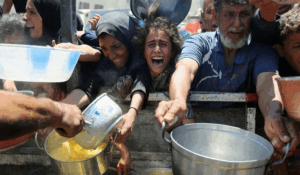UN says over 12,000 children in Gaza malnourished, including 2,562 severely, as public order collapses

Aid distribution in Gaza City on 2 August 2025
Nir Hasson reports in Haaretz on 7 August 2025:
At least 12,000 children in Gaza are suffering from malnutrition, including 2,562 who are severely malnourished, according to assessments by humanitarian organizations in Gaza, published Thursday in a biweekly report by the UN Office for the Coordination of Humanitarian Affairs.
The assessments, conducted in July, measured the mid-upper arm circumference of 136,000 children. While the overall malnutrition rate among children remains steady at 8.7 percent, the condition of those already affected has worsened. In June and July, 18 percent of malnourished children were diagnosed with severe acute malnutrition – up from 12 percent between March and May.
According to the organizations, only three percent of children in need of nutritional supplements have received them, as the collapse of public order in Gaza and the looting of aid trucks have severely disrupted the delivery of specialized food and medicine.
The report states that July’s data reflects a breakdown of the malnutrition prevention program, adding that the volume of aid entering the Strip is insufficient to prevent further deterioration in nutritional conditions.
Philippe Lazzarini, head of UNRWA, even said on Thursday that the situation in Gaza is such that “even the caregiver faints” due to the collapse of the entire humanitarian structure.
Another indication of the worsening hunger crisis in Gaza is the soaring cost of food. According to a market analysis by the World Food Programme, flour prices have dropped slightly, now ranging between 45 and 55 shekels per kilogram (up to about $16), following a partial easing of restrictions on aid truck deliveries.
However, prices remain volatile and heavily dependent on the arrival of new supplies. The cost of other basic staples remains exorbitantly high and far beyond the reach of most families; for instance, a kilogram of sugar now sells for 600 shekels (about $175).
Beyond the soaring prices, residents are also contending with a deepening cash shortage. Gazans receiving financial assistance from abroad are charged a 45 percent commission, and many merchants refuse to accept digital payments, further compounding the struggle to obtain food.
According to the report, alongside the spread of Guillain-Barré syndrome in Gaza, there has been a troubling increase in cases of meningitis. In July alone, 420 infections were reported. The World Health Organization said in a statement that an Israeli airstrike last month destroyed a warehouse storing much of the medication intended for treating the outbreak, leaving doctors in the Strip unable to respond effectively.
Meanwhile, hospitals across Gaza are operating at crisis levels, with occupancy rates between 180 and 300 percent. Last week, Al-Aqsa Hospital in Deir al-Balah declared it was collapsing under the pressure of treating hundreds of wounded patients. According to hospital staff, operating rooms have been shut down, and no beds remain available.

A child carrying water in Gaza City on 6 August 2025
The director of the HEAL Palestine–Kuwaiti Field Hospital in southern Gaza said the facility could no longer admit patients after receiving hundreds of casualties from Gaza Humanitarian Foundation food distribution sites. A report released Thursday by Médecins Sans Frontières added that its teams treated 174 gunshot victims, including 71 children, over two weeks in July, all arriving from GHF distribution centers.
The World Health Organization on Thursday also reported the recent evacuation of 47 patients for treatment outside Gaza, but estimates that more than 14,000 people are in urgent need of medical evacuation. Since Israel announced eased restrictions on humanitarian aid entry, the number of movement requests approved by the IDF for the UN and humanitarian organizations has improved.
However, despite this progress, approximately half of the aid convoys and humanitarian shipments within the Strip, including the entry and exit of medical teams and fuel deliveries, are still delayed at IDF checkpoints. According to the UN, these delays allow crowds to gather and loot aid trucks, resulting in most of the food being stolen and not reaching the warehouses.
Over a million shelter items, including tents, membrane structures and sealing materials, are currently stuck outside Gaza, as Israel has not permitted their entry. The condition of the tents where most Gazans live is dire and a recent survey found that 11 percent of families have no shelter at all.
Widespread evacuation orders issued by the IDF in recent months have forced many families to abandon their equipment or dismantle and reassemble it, further worsening their living conditions. The UN warns that the shortage of shelter materials is severely exacerbating the population’s health situation.
Meanwhile, humanitarian organizations in Gaza have recently succeeded in bringing in hygiene supplies for the first time since March. Among the items brought in, only to be looted, were sanitary pads, soap, and toilet paper. Additional trucks loaded with supplies are waiting outside the Strip, but according to the UN, Israel is not allowing them to enter.
Alongside aid trucks, approximately 100 trucks carrying equipment to support basic education services are also waiting to enter Gaza. Children in the Strip have not attended school normally for nearly two years, and aid groups operating learning centers now report that they are struggling to function due to shortages of supplies and ongoing evacuation orders.
In recent months, about half of these learning centers have been forced to close because of these evacuation orders. UNICEF and other organizations have reported a sharp increase in child neglect, forced child begging, exposure to violence, family breakdowns, as well as many children being wounded.
This article is reproduced in its entirety
